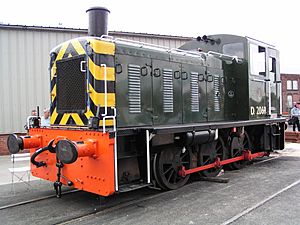British Rail Class 03 facts for kids
Quick facts for kids British Rail Class 03 |
|
 |
|
| Class 03 D2069 at Doncaster Works open day on 27 July 2003 | |
| Power type | Diesel-mechanical |
|---|---|
| Builder | BR Swindon & Doncaster |
| Build date | 1957–1961 |
| Configuration | 0-6-0 |
| UIC classification | C |
| Gauge | 4 ft 8 1⁄2 in (1,435 mm) |
| Wheel diameter | 3 ft 7 in (1.092 m) |
| Minimum curve | 2 chains (40 m) |
| Wheelbase | 9 ft 0 in (2.74 m) |
| Length | 26 ft 0 in (7.92 m) |
| Width | 8 ft 6 in (2.59 m) |
| Height | 11 ft 10 in (3.61 m) |
| Locomotive weight | 30.2 long tons (30.7 t) |
| Fuel capacity | 510 imp gal (2,300 L; 610 US gal) |
| Prime mover | Gardner 8L3 |
| Transmission | Wilson-Drewry CA5 R7, 5-speed epicyclic gearbox, RF11 spiral bevel reverse and final-drive unit. |
| Top speed | 28.5 mph (45.9 km/h) |
| Power output | Engine: 204 hp (152 kW) At rail: 152 hp (113 kW) |
| Tractive effort | Max: 15,650 lbf (69.6 kN) |
| Train heating | None |
| Locomotive brakeforce | 13 long tons-force (130 kN) |
| Train brakes | Vacuum (some dual Air & Vacuum) |
| Career | British Railways |
| Number | 11187–11209, 91, 92; later D2000–D2199, D2370–D2399; later 03004–03199, 03370–03399 |
| Axle load class | RA 1 |
| Retired | from April 1968 |
| Disposition | One still in service, over 50 preserved, most scrapped |
The British Rail Class 03 was a special type of small train, known as a shunter, used by British Railways. These tough little diesel trains were very successful and helped move railway wagons and carriages around busy train yards and stations. Built between 1957 and 1962, there were 230 of these useful locomotives.
Contents
What is a Shunter?
A shunter is like a powerful tugboat for trains! Its main job is to move railway wagons and carriages short distances. They work in places like train stations, goods yards, and industrial areas. Shunters help put trains together, move them to different tracks, or get them ready for longer journeys. The Class 03 was perfect for these tasks because it was small and strong.
Building These Locomotives
The Class 03 locomotives were built by British Railways itself. They were made at two famous railway workshops: Swindon and Doncaster. These workshops were very busy places where many trains were built and repaired.
How Many Were Built?
A total of 230 Class 03 locomotives were made. They were given special numbers to identify them.
- At first, they were numbered D2000 to D2199.
- Then, numbers D2370 to D2399 were added.
- Later, their numbers changed again to 03004 to 03399.
- Two of them, D2370 and D2371, were used for special railway tasks and were first numbered 91 and 92.
Key Features of the Class 03
The Class 03 was a diesel-mechanical shunter. This means it used a diesel engine to power its wheels through a gearbox, much like a car.
Engine and Power
Each Class 03 had a Gardner 8L3 engine. This engine could produce about 204 horsepower. While this might not sound like a lot compared to big modern trains, it was plenty for moving heavy wagons around a yard. They could pull with a maximum force of about 15,650 pounds.
Speed and Size
These shunters were not built for speed. Their top speed was around 28.5 miles per hour (46 km/h). They were designed for strength and control, not fast travel.
- They were about 26 feet (7.9 meters) long.
- They weighed around 30.2 long tons (30.7 tonnes).
- Their wheels were about 3 feet 7 inches (1.09 meters) across.
Life and Legacy
The Class 03 locomotives started working for British Railways in 1957. They were very reliable and worked hard for many years.
When They Retired
These locomotives began to be retired from service starting in April 1968. As newer, more powerful shunters were introduced, the Class 03s were gradually taken out of use.
Where Are They Now?
Even though most of them have been retired, the Class 03s were so well-loved that many were saved!
- Over 50 of these locomotives have been preserved. This means they are kept in museums or on heritage railways.
- Some are even still working on heritage lines, moving old carriages and giving rides to visitors.
- One Class 03 is still in active service today, which shows how tough and well-built they were!
The British Rail Class 03 remains an important part of railway history. They show how smaller, specialized trains played a huge role in keeping the railway network running smoothly.
See also
 In Spanish: British Rail Clase 03 para niños
In Spanish: British Rail Clase 03 para niños

